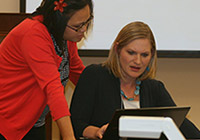TPS Consortium Member Showcase:
The University of California at Davis
The University of California at Davis (UC Davis), founded in 1905, is a top research and teaching university from one of the world’s pre-eminent public university systems. Spread out over 5,300 acres in the Central Valley, UC Davis serves 32,290 students in 102 undergraduate majors and 90 graduate programs and is geographically the largest UC campus. UC Davis is noted for its exceptional students and academic programs; international leadership and innovation in sustainability; and proven record in public service.

TPS-University of California, Davis workshops offer K-12 teachers opportunities to learn from both content experts and peers.
Headquartered at UC Davis is the California History-Social Science Project (CHSSP) statewide office. The CHSSP is a partnership between K-12 teachers and university scholars who work together to improve student understanding of history and the related social sciences, reading comprehension, and writing ability. It is part of the California Subject Matter Projects, a network of nine discipline-specific networks dedicated to improving classroom instruction to increase student achievement. The CHSSP is made up of six local sites, housed in departments of history at UC Berkeley, UC Davis, California State University (CSU) Fresno, UCLA, CSU Long Beach and Dominguez Hills, and UC Irvine. Since 1989, the CHSSP has provided teacher professional development programs, conducted research to better understand the impact of instruction upon student learning, and partnered with a variety of state and national institutions to promote the highest quality history education for K-12 students. A special focus of the CHSSP’s work has been providing research-based support for teachers of English Learners, native speakers with low literacy, and students from economically disadvantaged communities. This K-16 collaborative serves more than 2000 individual teachers from approximately 500 schools across California annually.
Given its focus on improved classroom instruction through the CHSSP, UC Davis enthusiastically joined the Library of Congress Teaching with Primary Sources (TPS) Educational Consortium in 2009. Using the Library’s substantial digital resources as the basis of a series of presentations, the TPS Program at UC Davis (TPS-UC Davis) offers a customized course of study for classroom teachers and librarians. While teachers may receive specific training in their grade level or content area, all courses provide the tools and guidance teachers need to include the Library’s digitized primary sources in their daily curriculum. As one teacher notes, “I see myself being able to use primary sources more on a daily basis now versus just a special part of a lesson.” TPS-UC Davis’s experienced and knowledgeable team of site directors, teacher leaders, historians, and graduate students help teachers explore the Library’s vast digital collections, apply effective practices, and use inquiry and historical investigation to engage students, improve learning, and increase reading comprehension and writing ability. TPS-UC Davis workshops and institutes are designed to enhance history instruction for teachers and are student centered.
More recently, TPS-UC Davis conducted its first series of TPS Level II summer institutes. Each three-day institute, “Migration and Immigration” and “Explorers and Encounters in America,” served teachers from across the state. Teachers spent significant time learning new ways to engage students with rigorous curriculum that helps students learn the content standards, and disciplinary and literacy skills. They responded positively to exploring the Library’s online exhibits and digital collections after historians piqued their curiosity and interest with content lectures. Teachers welcomed the challenge of creating original historical investigation lessons for classroom use in the 2011-12 school year. One teacher reflected on the experience, “I will be much more conscious of the implied veracity of our texts, I will encourage corroboration of facts and sources, and I will try to bring in more writing-for-a-purpose activities.” Follow up sessions to ensure that teachers use primary sources in instruction, assess student work, reflect upon their practice, and revise their TPS lesson based upon all of these components will reinforce and advance teachers’ instructional practices with primary sources. For more information, please contact chssp@ucdavis.edu.

